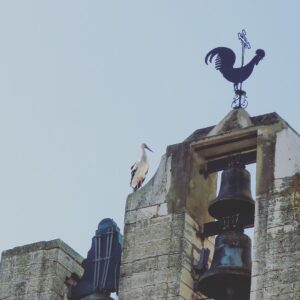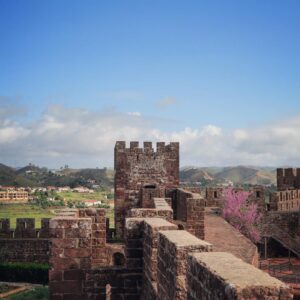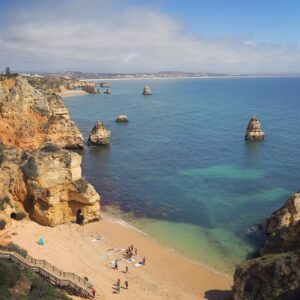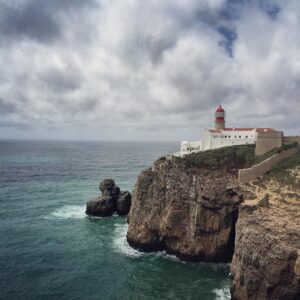One week to discover the south-west of Portugal – the Algarve region – and Lisbon.
We took off just two weeks after the attacks in Brussels, with extreme security measures announced. Luckily we booked our outbound tickets from the Brussels South Airport (Charleroi), which is the – small – low cost hub of Ryanair in Belgium. Security measures were not that though and we got through very easily and with very limited time loss. The bus (flibco) from Ghent straight to Charleroi Airport is a budget friendly and easy way to get there (book well in advance to get the cheapest ticket)!
 The flight to Faro took only about 2 hours. The airport itself is small, on the plus side it’s easy to find the car rental company. We arrived in the evening, but on our search for a restaurant we did discover a little bit of the town by night. With the hotel right next to the marina, and on the edge of the Ria Formosa National Park that couldn’t go wrong. First impression was a good one! On the second day we walked through the ancient part of Faro – the Cidade Velha.
The flight to Faro took only about 2 hours. The airport itself is small, on the plus side it’s easy to find the car rental company. We arrived in the evening, but on our search for a restaurant we did discover a little bit of the town by night. With the hotel right next to the marina, and on the edge of the Ria Formosa National Park that couldn’t go wrong. First impression was a good one! On the second day we walked through the ancient part of Faro – the Cidade Velha.
This part of Portugal was severely damaged by the earthquake in 1755, but nearly everything we saw or visited in the Algarve was restored. Including the cathedral of Faro. Typically Portuguese ornaments with the azulejo tiles, a nice garden with a creepy bones chapel, but most of all a lovely view over the town and the NP on top of the bell tower (check the 360 view here)! The company of a nesting stork made it complete. We paid € 3,5 per person to enter. We found more nesting storks on the Arco de Vila – the arch at the entrance of the old town. This arch appears to be unique in the region, built by the Moor around an 11th Century old gate. After a quick visit to the central market, we set off to discover more of the Algarve.
We wanted to visit the church in Almancil, but somehow we managed to miss that. The cross on top of the church is world heritage. Perhaps next time … In Alcantarilha we did find the Capela dos Ossos. Yes, again a bones chapel. Macabre but fascinating at the same time. And well preserved. Why on earth would you possibly want to build something out of bones and sculls? Our next stop – Porches – was a lot nicer. Although, we did visit our first Portuguese cemetery. Porches is known for its ceramic art work and potteries. Everything was closed so we wandered a bit through the streets and enjoyed the sunshine. A must-visit just 5 kilometres from Porches is the ‘Forte e capela de Senhora da Rocha’. A small chapel at the edge of the cliffs (forget about the ugly tourist town just before you find this gem). The views over the ocean are magnificent! After dropping off our bags at our hotel – in the hinterland but with a seaside view! – we dined at a beautiful place (not necessarily the best food) and enjoyed a lovely sunset at Rocha Brava (in Alfanzina). Mind the sinkholes (algar in Portuguese)!
 Every town and small village is so close by, you could easily drive from Faro to Sagres in one day, but we enjoyed the region and the coastline at a nice pace. On the third day of our road trip, we didn’t drive that far. From our hotel it was about 15 kms to Silves, a town more inland, but about the only town inland we were about to visit (this is a coastline road trip after all). After a small detour off road (we missed driving these kinds of roads
Every town and small village is so close by, you could easily drive from Faro to Sagres in one day, but we enjoyed the region and the coastline at a nice pace. On the third day of our road trip, we didn’t drive that far. From our hotel it was about 15 kms to Silves, a town more inland, but about the only town inland we were about to visit (this is a coastline road trip after all). After a small detour off road (we missed driving these kinds of roads 
The limestone coast erodes in the same way, with similar ‘pylons’ towering in the ocean. An absolute must is the walk left from the car park. After the steps down to the beach the walkway gets empty, and it’s easy to find a nice spot to enjoy the magnificent panorama.  This region is the best place to get yourself in a small boat and discover the coastline from the water. We’ve read so many nice things about it, and indeed, it must be the best way to discover the many caves and ‘algars’ from another perspective. But after seeing some of those boats ‘entertaining’ the passengers, and knowing the ocean was a bit rough, we decided to stay dry and safe.
This region is the best place to get yourself in a small boat and discover the coastline from the water. We’ve read so many nice things about it, and indeed, it must be the best way to discover the many caves and ‘algars’ from another perspective. But after seeing some of those boats ‘entertaining’ the passengers, and knowing the ocean was a bit rough, we decided to stay dry and safe.
Nevertheless, we got to see more spectacular nature art works! Algar Seco is perhaps the most visited place during the season, but with a reason. Go down at the Bonera Bar, be careful and enjoy the view after some climbing! The path way further on the right leads to more beautiful lookouts. Driving from one beach to another never gets tiring! One of the last remaining fishing villages didn’t really have that much of a surprise to us. Except for the view over the ugly city of Portimao (where we didn’t stop, same for Albufeira). Our last stop of the day – Lagos – was nicer. We stopped at Praia de Dona Ana and decided to go to the Ponta da Piedade before darkness came in. The next day we came back at the same place, and luckily we did so! We discovered far more beautiful spots at this place than the day before (we had to run for a nasty shower). Although this town has a lot of history, being a place where slaves were traded back in the medieval times, we didn’t go into town. Instead, we wanted to enjoy everything nature offers to this absolutely gorgeous region. So we headed to ‘the end of the world’.
 Sagres is a small village, the most westerly inhabited place of Europe, with a lovely atmosphere. Perhaps because it is quite isolated, or because the real tourist season hasn’t began yet, but we absolutely loved it! The Cabo de Sao Vicente (the real end of the world) is just stunning! From here, many expeditions to discover the world were made. An important place in maritime history! Just imaging how people thought ships were about to fall from the horizon, not knowing they would go on till the New World … Be sure to take a wind jacket. The Fortaleza de Beliche is a good stop, not to visit the old fortress, but to go down on the walking path towards the sea. The beach a bit further is also a must! The fortress of Sagres (€ 3 per person) is not that spectacular as a fortress (and when we visited, construction works were on-going), but the views are amazing (check the 360 view here)! Go out and walk! A little church from the 16th Century is a nice surprise. According to the legend, Prince Henry (the one who laid the foundations of the maritime history) decided to build the church where the ravens told him the remains of a saint were to be found. The Portuguese flag still refers to this event. The giant wind rose on the ground is startling, especially because we don’t have a clue about how to measure the wind direction by this instrument
Sagres is a small village, the most westerly inhabited place of Europe, with a lovely atmosphere. Perhaps because it is quite isolated, or because the real tourist season hasn’t began yet, but we absolutely loved it! The Cabo de Sao Vicente (the real end of the world) is just stunning! From here, many expeditions to discover the world were made. An important place in maritime history! Just imaging how people thought ships were about to fall from the horizon, not knowing they would go on till the New World … Be sure to take a wind jacket. The Fortaleza de Beliche is a good stop, not to visit the old fortress, but to go down on the walking path towards the sea. The beach a bit further is also a must! The fortress of Sagres (€ 3 per person) is not that spectacular as a fortress (and when we visited, construction works were on-going), but the views are amazing (check the 360 view here)! Go out and walk! A little church from the 16th Century is a nice surprise. According to the legend, Prince Henry (the one who laid the foundations of the maritime history) decided to build the church where the ravens told him the remains of a saint were to be found. The Portuguese flag still refers to this event. The giant wind rose on the ground is startling, especially because we don’t have a clue about how to measure the wind direction by this instrument 
After this absolutely amazing stretch of coastline, from Faro till Sagres, we had to follow the west coast (Costa Vicentina) – north to Lisbon. Unfortunately, we had some bad luck with the weather, but we still got to see some beaches. Which were, again, stunning! We stopped at Praia da Cordama, a little bit south from Vila do Bispo. The prehistoric menhirs and rocks are to be found in the hills around this village. We discovered Aljezur and skipped the beaches in between (we were glad to make it safe and sound to this village). Aljezur is small but beautiful, walking through the old part of town, visiting the castle and enjoying the view over the new part of town and the wetlands around. By that time, the sun accompanied us as she did the last week. At night, we ended up at a small restaurant a bit out of Zambujeira do Mar and enjoyed the sunset at one of the lookouts.
Tips:
- try Paparazzi in Faro. Cheap, friendly service and good food.
- O Pescador is set at a lovely spot near Benagil, but the food is too expensive for the quality you get.
- In Sagres, the best tip to eat is absolutely The Hangout!
- Be aware of the driving skills of Portuguese drivers. Especially when it rains (overtaking when the narrow road turns into a swimming pool is not exceptional) and at roundabouts.
